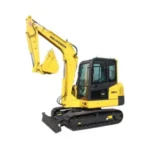Introdução

In the realm of construction machinery, front wheel loaders have emerged as indispensable tools, transforming the landscape of construction projects worldwide. This blog explores how these robust machines have revolutionized the efficiency, versatility, and safety of construction operations.
Evolution of Front Wheel Loaders
Front wheel loaders have a rich history dating back to the mid-20th century. Initially developed for agricultural purposes, these machines quickly found their place in construction due to their ability to maneuver various terrains and handle heavy loads efficiently. This section delves into the key technological advancements that have shaped modern wheel loaders.
Key Features and Components
Understanding the anatomy of front wheel loaders is crucial for appreciating their operational prowess. From hydraulic systems to bucket attachments, each component plays a vital role in enhancing functionality and performance. This section provides a detailed breakdown of the essential features that contribute to the efficiency and reliability of wheel loaders.
Applications in Construction Projects
Front wheel loaders are versatile machines capable of performing a wide range of tasks on construction sites. From loading and transporting materials to excavation and site preparation, their adaptability makes them invaluable assets across various construction phases. This section explores the diverse applications of front wheel loaders and their impact on project timelines and costs.
Advantages Over Other Machinery
Comparative analysis reveals the distinct advantages of wheel loaders over alternative construction equipment such as excavators and bulldozers. Factors such as maneuverability, speed, and operational flexibility contribute to their preference in different construction scenarios. This section highlights these advantages through case studies and real-world examples.
Environmental and Safety Considerations
In an era of increasing environmental awareness and stringent safety regulations, wheel loaders have made significant strides in minimizing their ecological footprint and enhancing operator safety. Innovations in engine efficiency, emissions control, and ergonomic design contribute to sustainable construction practices. This section explores these considerations in detail.
Case Studies and Success Stories
Examining successful implementations of wheel loaders in notable construction projects provides insights into their transformative impact. Case studies from infrastructure development, mining operations, and urban construction projects illustrate how these machines have overcome challenges and delivered exceptional results. This section showcases the versatility and reliability of front wheel loaders in diverse environments.
Typical Specifications and Features of Front Wheel Loaders
| Feature | Descrição |
|---|---|
| Engine Power | Typically ranges from 100 to 500+ horsepower |
| Bucket Capacity | Varies from 1 to 10+ cubic yards |
| Peso operacional | Usually between 10,000 to 100,000+ pounds |
| Maximum Speed | Around 20 to 40 miles per hour |
| Fuel Capacity | Holds approximately 50 to 200+ gallons |
| Hydraulic System | Provides lifting capacity and operational control |
| Transmission Type | Options include manual, automatic, hydrostatic |
| Tire Size | Large, durable tires for rough terrain |
| Cabin Features | Air-conditioned, ergonomic controls |
| Características de segurança | ROPS/FOPS certified, backup cameras |
| Anexos | Quick couplers for various tools and buckets |
Operational Best Practices
Effective operation of front wheel loaders requires skill and adherence to best practices. This section offers practical tips and guidelines for operators to maximize efficiency, maintain safety standards, and prolong the lifespan of equipment. Insights from industry experts and experienced operators provide invaluable advice for enhancing productivity on construction sites.
Maintenance and Servicing

Regular maintenance and servicing are essential for ensuring the longevity and optimal performance of wheel loaders. This section discusses the importance of routine inspections, preventative maintenance schedules, and the role of qualified technicians in minimizing downtime and reducing operational costs.
Conclusão
Front wheel loaders have undoubtedly revolutionized construction projects through their versatility, efficiency, and safety features. As technology continues to evolve, these machines are expected to play an even more pivotal role in shaping the future of construction machinery. This blog has explored the evolution, features, applications, advantages, environmental considerations, operational best practices, maintenance, and servicing of wheel loaders, highlighting their indispensable nature in modern construction.
Perguntas frequentes
Q: What are the primary advantages of using front wheel loaders over other construction machinery?
A:Front wheel loaders offer superior maneuverability, speed, and versatility compared to alternatives like excavators and bulldozers. They excel in tasks requiring frequent movement of materials across varied terrains.
Q: How can operators ensure the optimal performance of wheel loaders?
A:Regular maintenance, adherence to operational guidelines, and ongoing training for operators are essential for maximizing the efficiency and longevity of wheel loaders.
Q: What innovations have enhanced the environmental sustainability of front wheel loaders?
A:Advancements in engine technology, emissions control systems, and the use of alternative fuels have significantly reduced the environmental impact of front wheel loaders, aligning with global sustainability goals.
Q: What are some common challenges faced when operating wheel loaders?
A:Common challenges include terrain variability, operator fatigue, and maintenance issues. Overcoming these challenges requires training, proper equipment upkeep, and strategic planning.
Q: How do front wheel loaders contribute to cost savings on construction projects?
A:By streamlining operations, reducing labor costs, and enhancing productivity, front wheel loaders contribute to significant cost savings throughout the construction process.







-150x150.webp)
